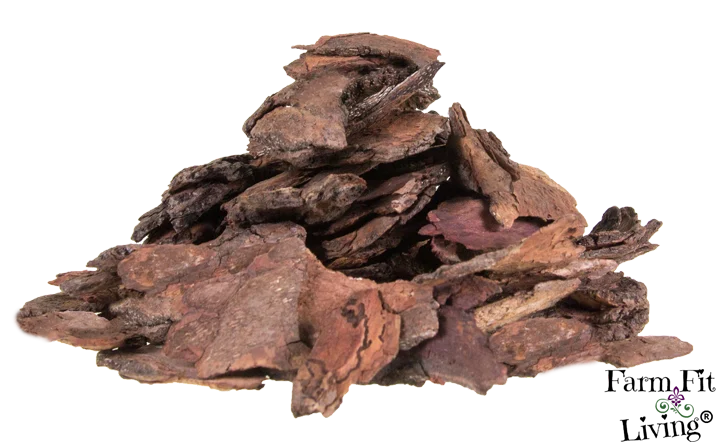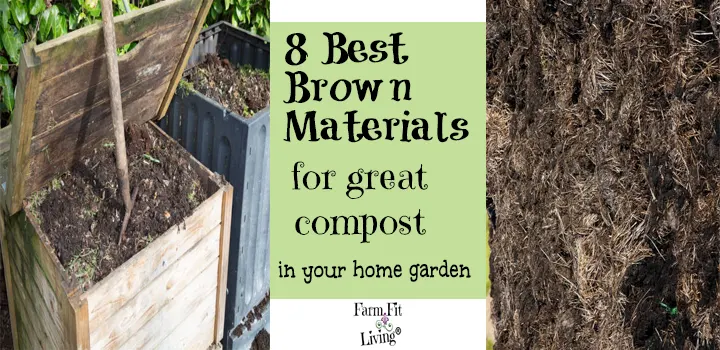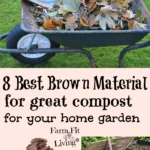If you’re wanting to improve your compost pile, you need to know about the best brown material for great compost!
Brown can be known as “boring.” And as you look at this list of the best brown material for great compost, you’ll find there’s a lot of “trash” on it.
The green side of composting is much more fun. Keep reading for the green compost list because you need to know the best green items to mix with your brown carbon-rich material. The two really needs to be mixed together for best results. Why?
In this post, I will share:
- The 8 best brown material for great compost.
- Proper Composting Mixes.
- Why a compost brown list is key to successful compost.
This post contains Affiliate Links. This means if you click and buy, I might make a commission at no cost to you.
See my policy for more information
Best Brown Material for Great Compost: Dry Leaves
If you have deciduous leafy shade trees on your property, you’ll going to have dead leaves drop in the Fall. That’s a no-brainer.
But then, you’ll have to pick up all those leaves. This can be a huge chore to get rid of yard waste! Why not turn this chore into a valuable item on your compost brown list?
The compost bin is a great place for those leaves to go. They are one of the best brown material for great compost and very easy to obtain. Don’t have trees? No problem! Offer to pick up your neighbor’s or friend’s leaves and other organic materials from their yard.
Leaves are everywhere. You just have to know where to look. Just make sure they are dry when you put them into your compost heap.
Straw
Old straw is organic waste that makes great compost. And if you’ve used the straw for bedding, you’ve got the manure (green) mixed in already! The decomposition process is already taking place to making a great black gold compost activator.
When we clean out our animal pens, we either put it into a manure spreader and spread it onto the garden. Or we layer it into our compost where it’ll mix with the nitrogen-rich materials to make a crumbly compost. We have a heavy clay soil so compost does wonders to break it down and make a better soil.
New straw can make really good compost as well. If you don’t live in wheat country like I do, you may not have access to straw of any sort. That’s ok! There’s other items on this compost brown list that are more accessible. Like paper.
Paper
Chances are, you have old paper sitting around that you don’t know what to do with. Paper and paper towels are a great addition to proper composting mixes! A common problem I have is all the paper the kids bring home from school that I don’t want to keep. Of course, I keep their most precious school projects but things like old school notes or work sheets that we don’t really care to keep are compostable materials.
One thing I recommend is to shred the paper or tear it into small pieces. This will help the paper break down better throughout its life in the good compost pile.
Shredded Tree Parts
Old dead trees are best. Or if you’ve been pruning your trees, cut them up into smaller pieces and throw them in.
It’s going to take a little bit longer for these tree parts to actually break down. However, tree parts have a great amount of carbon for proper composting mixes so it’s well worth the wait to let it break down.
The next item on the list will break down a lot faster.

Saw Dust
More tree parts! Saw dust or wood shavings is going to break down even better, making it one of the best brown materials for great compost.
It’s less accessible if you don’t have a saw mill nearby. If you do have a saw mill near by, you should be able to walk in and ask for some saw dust.
And if you’re interested in doing any woodworking, this is a great opportunity to not only invest in a hobby but obtain some great brown material for your compost bin.
If you’re just starting out, you can get a simple table saw with bags to catch your saw dust.
Pine Needles
Pines will lose their needles. You can rake them up and throw them into your compost. Easy Peasy.
Pine needles, also known as pine straw, can make good compost for several reasons:
- Carbon-rich: Pine needles are high in carbon, which makes them a great “brown” material for composting. They help balance the nitrogen-rich “green” materials in your compost pile.
- Slow decomposition: Pine needles break down slowly, which can help maintain aeration and structure in your compost pile. They also help create air pockets that allow oxygen to reach the microorganisms responsible for decomposition.
- Acidic nature: While pine needles are acidic when fresh, they become more neutral as they decompose. This can be beneficial for acid-loving plants when the compost is used in the garden.
- Texture: The fibrous texture of pine needles helps improve the overall structure of the compost, allowing for better air circulation and water retention.
- Readily available: In areas where pine trees are common, pine needles are often abundant and easy to collect, making them a convenient source of compostable material.
Overall, pine needles can be a valuable addition to your compost pile, helping to create nutrient-rich compost that can improve the health of your soil and plants. They will break down super easily in the bin.
Nut Shells
Even though the best part of the nut is gone, the shells are still usable. They make great brown compost material.
In a nut shell, any nut will do. Acorns, black walnuts, peanuts etc are all very accessible trees that produce plenty of nuts.
And if you don’t have access to these nuts, contact a factory to see if they would give you the shells. It never hurts to ask.
Dryer Lint
Who knew? Instead of throwing this away, throw it into the compost bin. This is a really good way to reuse the lint from your dryers that you would normally throw out.

Making Your Own Compost Successfully
A proper composting mix includes a balance of “green” and “brown” materials, along with air and water. Here’s a general guideline for a balanced compost mix:
- Green materials (nitrogen-rich): These materials are typically moist and include kitchen scraps (fruit and vegetable peels, coffee grounds, tea bags), fresh grass clippings, and plant trimmings. Aim for a mix of about 1/3 green materials. (READ MORE ABOUT GREEN MATERIALS)
- Brown materials (carbon-rich): These materials are dry and include leaves, straw, shredded paper, cardboard, and wood chips. Aim for a mix of about 2/3 brown materials.
- Air: Oxygen is essential for the composting process, so be sure to aerate your compost pile regularly by turning it with a pitchfork or shovel.
- Water: Moisture is important for the composting process, but the pile should not be too wet. Aim for a damp sponge-like consistency.
- Microorganisms: These are responsible for breaking down the organic matter in your compost pile. They are naturally present in the materials you add to the pile, but you can also add compost starter or finished compost to introduce more microorganisms.
By maintaining a proper balance of green and brown materials, along with air and water, you can create a healthy compost pile that decomposes efficiently and produces nutrient-rich compost for your garden.
Materials to Avoid in Your Compost
While many brown materials are excellent for composting, some should be avoided due to potential issues they can cause in the compost pile. Here are some brown materials that are generally not recommended for composting:
- Sawdust or wood chips from treated wood: These materials can contain chemicals that are harmful to plants and should not be used in compost.
- Coal or charcoal ash: Ash from coal or charcoal can contain substances that are harmful to plants and should not be used in compost.
- Diseased plants: Plants that are diseased should not be composted, as the disease can survive the composting process and be spread to other plants when the compost is used.
- Pet waste: Pet waste can contain pathogens that are harmful to humans, so it should not be composted in a pile that will be used on edible crops.
- Black walnut leaves or twigs: Black walnut trees produce a chemical called juglone that can inhibit the growth of other plants, so it’s best to avoid composting their leaves or twigs.
- Meat, bones, or dairy products: These materials can attract pests and create odors, so they are best avoided in compost piles.
While these materials are not recommended for composting, there are many other brown materials that are beneficial and can be used to create nutrient-rich compost.
Best Brown Material for Great Compost: Mix with Green Compost for Best Results!
Again, the brown may be boring stuff. But your compost needs both to thrive! You need to have the right mix of browns and greens in order to make the right balance of organic material. A ratio of 2:1 Nitrogen to Carbon is a really good mix for a usable compost.
Because ultimately, your compost will become soil. It’s the first step to building up your garden for plentiful and bountiful fertility in the long run.

Make Gardening Simple Now!

Simple gardening equals smart gardening. In this short, easy to read book, you'll get access to all the best practices and tips for gardening smarter and more successfully. If you want more information, I'll send it right to your email inbox!

